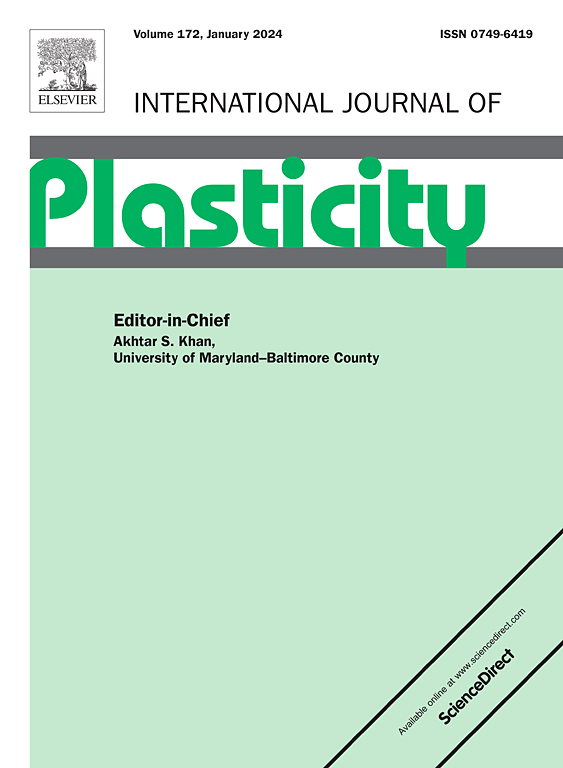一种可推广的机器学习辅助快速傅立叶变换算法来模拟多晶材料中的大应变现象
IF 12.8
1区 材料科学
Q1 ENGINEERING, MECHANICAL
引用次数: 0
摘要
机器学习方法在单晶或均质多晶的本构建模中显示出了初步的前景,提供了显著的计算效率。然而,现有的基于机器学习的本构模型往往缺乏泛化性,限制了它们在不同边值问题中的应用。本研究引入了一种基于热力学的人工神经网络模型,用于加速速率-切线晶体塑性的快速傅立叶变换模拟多晶在复杂载荷下的跨尺度变形行为。我们的模型有效地整合了微观结构变异性和局部相互作用。为了解决每个晶粒中的局部效应,我们采用K-means聚类将微观结构中的高斯点分组为假设处于相似力学状态的簇。该方法基于自聚类分析,将模型范围从宏观应力响应扩展到颗粒水平,捕捉颗粒间的力学响应和取向演化。这减少了需要解决的非线性问题的数量,集群响应在每个组中传播。利用局部材料状态簇对基于热力学的人工神经网络提取的特征进行进一步处理,以解释与历史相关的变形和进化的微观结构。此外,采用速率切线晶体塑性快速傅里叶变换的代表性体元模拟为模型训练提供了可靠的数据集。该模型在预测复杂加载条件下(如双向拉伸和任意加载)的应变-应力响应和取向演化方面具有较高的效率、准确性、自一致性和较强的通用性。本文章由计算机程序翻译,如有差异,请以英文原文为准。
A generalizable machine learning-assisted fast Fourier transform algorithm to simulate the large strain phenomena in polycrystalline materials
Machine learning methods have shown initial promise in constitutive modeling for single crystals or homogenized polycrystals, delivering notable computational efficiency. However, existing machine learning-based constitutive models often lack generalizability, limiting their application across diverse boundary value problems. This study introduces a thermodynamics-informed artificial neural network model to accelerate rate-tangent crystal plasticity fast Fourier transform simulations for cross-scale deformation behaviors of polycrystals under complex loading. Our model integrates microstructural variability and local interactions effectively. To address local effects in each grain, we employ K-means clustering to group Gauss points within the microstructure into clusters assumed to be in similar mechanical states. This approach, based on self-clustering analysis, extends model scope from macroscopic stress response to the granular level, capturing mechanical responses and orientation evolution across grains. This reduces the number of nonlinear problems to solve, with cluster responses propagated throughout each group. The thermodynamics-based artificial neural network-extracted features are further processed using local material state clusters to account for history-dependent deformation and evolving microstructures. Additionally, representative volume element simulations with rate-tangent crystal plasticity fast Fourier transform provide reliable datasets for model training. The proposed model demonstrates high efficiency, accuracy, self-consistency, and enhanced generalizability in predicting strain–stress responses and orientation evolution at both individual grain and aggregate scales under complex loading conditions, such as biaxial tension and arbitrary loading scenarios.
求助全文
通过发布文献求助,成功后即可免费获取论文全文。
去求助
来源期刊

International Journal of Plasticity
工程技术-材料科学:综合
CiteScore
15.30
自引率
26.50%
发文量
256
审稿时长
46 days
期刊介绍:
International Journal of Plasticity aims to present original research encompassing all facets of plastic deformation, damage, and fracture behavior in both isotropic and anisotropic solids. This includes exploring the thermodynamics of plasticity and fracture, continuum theory, and macroscopic as well as microscopic phenomena.
Topics of interest span the plastic behavior of single crystals and polycrystalline metals, ceramics, rocks, soils, composites, nanocrystalline and microelectronics materials, shape memory alloys, ferroelectric ceramics, thin films, and polymers. Additionally, the journal covers plasticity aspects of failure and fracture mechanics. Contributions involving significant experimental, numerical, or theoretical advancements that enhance the understanding of the plastic behavior of solids are particularly valued. Papers addressing the modeling of finite nonlinear elastic deformation, bearing similarities to the modeling of plastic deformation, are also welcomed.
 求助内容:
求助内容: 应助结果提醒方式:
应助结果提醒方式:


